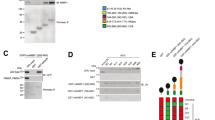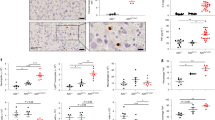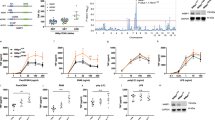Abstract
The ubiquitin-editing enzyme A20 is a critical negative regulator of inflammation and cytokine-mediated activation of the transcription factor NF-κB; however, little is known about the mechanisms of A20-mediated inactivation of signaling intermediates such as RIP1. Here we demonstrate that the regulatory molecule TAX1BP1 recruited the E3 ligase Itch to A20 via two 'PPXY' motifs. Itch was essential for the termination of tumor necrosis factor receptor signaling by controlling A20-mediated recruitment and inactivation of RIP1. Furthermore, the Tax oncoprotein of human T cell leukemia virus type I targeted this complex for inactivation by disrupting the interaction among TAX1BP1, A20 and Itch. Thus, our studies show a previously unappreciated complexity of A20 substrate recognition and inactivation whereby TAX1BP1 and Itch function as essential subunits of an A20 ubiquitin-editing complex.
This is a preview of subscription content, access via your institution
Access options
Subscribe to this journal
Receive 12 print issues and online access
$209.00 per year
only $17.42 per issue
Buy this article
- Purchase on SpringerLink
- Instant access to full article PDF
Prices may be subject to local taxes which are calculated during checkout







Similar content being viewed by others
References
Serhan, C.N. Resolution phase of inflammation: novel endogenous anti-inflammatory and proresolving lipid mediators and pathways. Annu. Rev. Immunol. 25, 101–137 (2007).
Karin, M. & Greten, F.R. NF-κB: linking inflammation and immunity to cancer development and progression. Nat. Rev. Immunol. 5, 749–759 (2005).
Lawrence, T. & Gilroy, D.W. Chronic inflammation: a failure of resolution? Int. J. Exp. Pathol. 88, 85–94 (2007).
Karin, M. & Ben-Neriah, Y. Phosphorylation meets ubiquitination: the control of NF-κB activity. Annu. Rev. Immunol. 18, 621–663 (2000).
Hayden, M.S. & Ghosh, S. Signaling to NF-κB. Genes Dev. 18, 2195–2224 (2004).
Hacker, H. & Karin, M. Regulation and function of IKK and IKK-related kinases. Sci. STKE 357, re13 (2006).
Rothwarf, D.M. & Karin, M. The NF-κB activation pathway: a paradigm in information transfer from membrane to nucleus. Sci. STKE 5, re1 (1999).
Sun, S.C., Ganchi, P.A., Ballard, D.W. & Greene, W.C. NF-κB controls expression of inhibitor IκBα: evidence for an inducible autoregulatory pathway. Science 259, 1912–1915 (1993).
Reiley, W., Zhang, M. & Sun, S.C. Negative regulation of JNK signaling by the tumor suppressor CYLD. J. Biol. Chem. 279, 55161–55167 (2004).
Massoumi, R., Chmielarska, K., Hennecke, K., Pfeifer, A. & Fassler, R. Cyld inhibits tumor cell proliferation by blocking Bcl-3-dependent NF-κB signaling. Cell 125, 665–677 (2006).
Brummelkamp, T.R., Nijman, S.M., Dirac, A.M. & Bernards, R. Loss of the cylindromatosis tumour suppressor inhibits apoptosis by activating NF-κB. Nature 424, 797–801 (2003).
Kovalenko, A. et al. The tumour suppressor CYLD negatively regulates NF-κB signalling by deubiquitination. Nature 424, 801–805 (2003).
Trompouki, E. et al. CYLD is a deubiquitinating enzyme that negatively regulates NF-κB activation by TNFR family members. Nature 424, 793–796 (2003).
Jono, H. et al. NF-κB is essential for induction of CYLD, the negative regulator of NF-κB: evidence for a novel inducible autoregulatory feedback pathway. J. Biol. Chem. 279, 36171–36174 (2004).
Lee, E.G. et al. Failure to regulate TNF-induced NF-κB and cell death responses in A20-deficient mice. Science 289, 2350–2354 (2000).
Krikos, A., Laherty, C.D. & Dixit, V.M. Transcriptional activation of the tumor necrosis factor α-inducible zinc finger protein, A20, is mediated by κB elements. J. Biol. Chem. 267, 17971–17976 (1992).
Wertz, I.E. et al. De-ubiquitination and ubiquitin ligase domains of A20 downregulate NF-κB signalling. Nature 430, 694–699 (2004).
Boone, D.L. et al. The ubiquitin-modifying enzyme A20 is required for termination of Toll-like receptor responses. Nat. Immunol. 5, 1052–1060 (2004).
Hutti, J.E. et al. IκB kinase β phosphorylates the K63 deubiquitinase A20 to cause feedback inhibition of the NF-κB pathway. Mol. Cell. Biol. 27, 7451–7461 (2007).
Shembade, N., Harhaj, N.S., Liebl, D.J. & Harhaj, E.W. Essential role for TAX1BP1 in the termination of TNF-α-, IL-1- and LPS-mediated NF-κB and JNK signaling. EMBO J. 26, 3910–3922 (2007).
De Valck, D. et al. The zinc finger protein A20 interacts with a novel anti-apoptotic protein which is cleaved by specific caspases. Oncogene 18, 4182–4190 (1999).
Ling, L. & Goeddel, D.V. T6BP, a TRAF6-interacting protein involved in IL-1 signaling. Proc. Natl. Acad. Sci. USA 97, 9567–9572 (2000).
Morriswood, B. et al. T6BP and NDP52 are myosin VI binding partners with potential roles in cytokine signalling and cell adhesion. J. Cell Sci. 120, 2574–2585 (2007).
Jin, D.Y. et al. A human suppressor of c-Jun N-terminal kinase 1 activation by tumor necrosis factor α. J. Biol. Chem. 272, 25816–25823 (1997).
Grant, C. et al. Human T cell leukemia virus type I and neurologic disease: events in bone marrow, peripheral blood, and central nervous system during normal immune surveillance and neuroinflammation. J. Cell. Physiol. 190, 133–159 (2002).
Yoshida, M., Miyoshi, I. & Hinuma, Y. Isolation and characterization of retrovirus from cell lines of human adult T-cell leukemia and its implication in the disease. Proc. Natl. Acad. Sci. USA 79, 2031–2035 (1982).
Harhaj, E.W. & Sun, S.C. IKKγ serves as a docking subunit of the IκB kinase (IKK) and mediates interaction of IKK with the human T-cell leukemia virus Tax protein. J. Biol. Chem. 274, 22911–22914 (1999).
Jin, D.Y., Giordano, V., Kibler, K.V., Nakano, H. & Jeang, K.T. Role of adapter function in oncoprotein-mediated activation of NF-κB: human T-cell leukemia virus type I Tax interacts directly with IκB kinase γ. J. Biol. Chem. 274, 17402–17405 (1999).
Chu, Z.L., Shin, Y.A., Yang, J.M., DiDonato, J.A. & Ballard, D.W. IKKγ mediates the interaction of cellular IκB kinases with the Tax transforming protein of human T cell leukemia virus type 1. J. Biol. Chem. 274, 15297–15300 (1999).
Sun, S.C. & Ballard, D.W. Persistent activation of NF-κB by the Tax transforming protein of HTLV-1: hijacking cellular IκB kinases. Oncogene 18, 6948–6958 (1999).
Harhaj, E.W. & Harhaj, N.S. Mechanisms of persistent NF-κB activation by HTLV-I Tax. IUBMB Life 57, 83–91 (2005).
Chin, K.T., Chun, A.C., Ching, Y.P., Jeang, K.T. & Jin, D.Y. Human T-cell leukemia virus oncoprotein Tax represses nuclear receptor-dependent transcription by targeting coactivator TAX1BP1. Cancer Res. 67, 1072–1081 (2007).
Sudol, M., Chen, H.I., Bougeret, C., Einbond, A. & Bork, P. Characterization of a novel protein-binding module-the WW domain. FEBS Lett. 369, 67–71 (1995).
Hustad, C.M. et al. Molecular genetic characterization of six recessive viable alleles of the mouse agouti locus. Genetics 140, 255–265 (1995).
Fang, D. et al. Dysregulation of T lymphocyte function in itchy mice: a role for Itch in TH2 differentiation. Nat. Immunol. 3, 281–287 (2002).
Chang, L. et al. The E3 ubiquitin ligase Itch couples JNK activation to TNFα-induced cell death by inducing c-FLIPL turnover. Cell 124, 601–613 (2006).
Kwon, H. et al. Lethal cutaneous disease in transgenic mice conditionally expressing type I human T cell leukemia virus Tax. J. Biol. Chem. 280, 35713–35722 (2005).
Mauro, C. et al. ABIN-1 binds to NEMO/IKKγ and co-operates with A20 in inhibiting NF-κB. J. Biol. Chem. 281, 18482–18488 (2006).
Wullaert, A. et al. LIND/ABIN-3 is a novel lipopolysaccharide-inducible inhibitor of NF-κB activation. J. Biol. Chem. 282, 81–90 (2007).
Song, H.Y., Rothe, M. & Goeddel, D.V. The tumor necrosis factor-inducible zinc finger protein A20 interacts with TRAF1/TRAF2 and inhibits NF-κB activation. Proc. Natl. Acad. Sci. USA 93, 6721–6725 (1996).
Tsitsikov, E.N. et al. TRAF1 is a negative regulator of TNF signaling: enhanced TNF signaling in TRAF1-deficient mice. Immunity 15, 647–657 (2001).
Bienko, M. et al. Ubiquitin-binding domains in Y-family polymerases regulate translesion synthesis. Science 310, 1821–1824 (2005).
Wu, X. & Sun, S.C. Retroviral oncoprotein Tax deregulates NF-κB by activating Tak1 and mediating the physical association of Tak1-IKK. EMBO Rep. 8, 510–515 (2007).
Zhou, H. et al. Bcl10 activates the NF-κB pathway through ubiquitination of NEMO. Nature 427, 167–171 (2004).
Uchiyama, T. Human T cell leukemia virus type I (HTLV-I) and human diseases. Annu. Rev. Immunol. 15, 15–37 (1997).
Heissmeyer, V. et al. Calcineurin imposes T cell unresponsiveness through targeted proteolysis of signaling proteins. Nat. Immunol. 5, 255–265 (2004).
Storz, P., Döppler, H., Ferran, C., Grey, S.T. & Toker, A. Functional dichotomy of A20 in apoptotic and necrotic cell death. Biochem. J. 387, 47–55 (2005).
Xiao, G., Harhaj, E.W. & Sun, S.C. NF-κB-inducing kinase regulates the processing of NF-κB2 p100. Mol. Cell 7, 401–409 (2001).
Harhaj, N.S., Sun, S.C. & Harhaj, E.W. Activation of NF-κB by the human T cell leukemia virus type I Tax oncoprotein is associated with ubiquitin-dependent relocalization of IκB kinase. J. Biol. Chem. 282, 4185–4192 (2007).
Shembade, N., Harhaj, N.S., Yamamoto, M., Akira, S. & Harhaj, E.W. The human T-cell leukemia virus type 1 Tax oncoprotein requires the ubiquitin-conjugating enzyme Ubc13 for NF-κB activation. J. Virol. 81, 13735–13742 (2007).
Acknowledgements
We thank S. Sun, G. Barber, K. Tolba and C. Vincenz for reagents; A. Angers (University of Montreal) for plasmid encoding Flag-Itch; J. Tschopp (University of Lausanne) for Flag–c-FLIP(L); P. Storz (Mayo Clinic, Jacksonville) for pSUPER and pSUPER A20-specific siRNA; W. Greene (Gladstone Institute for Virology and Immunology) for Jurkat Tax Tet-on cells; and D.A. Swing, R. Koogle and J.B. Lea for assistance with mouse husbandry. Supported by the University of Miami Scientific Awards Committee.
Author information
Authors and Affiliations
Contributions
N.S., N.S.H., K.P. and L.E.M. did experiments and analyzed data; N.G.C., N.A.J. and L.E.M. provided essential reagents; L.E.M. assisted in writing the manuscript; and E.W.H. designed and supervised the experiments, analyzed data and wrote the manuscript.
Corresponding author
Supplementary information
Supplementary Text and Figures
Supplementary Figures 1–2 (PDF 87 kb)
Rights and permissions
About this article
Cite this article
Shembade, N., Harhaj, N., Parvatiyar, K. et al. The E3 ligase Itch negatively regulates inflammatory signaling pathways by controlling the function of the ubiquitin-editing enzyme A20. Nat Immunol 9, 254–262 (2008). https://doi.org/10.1038/ni1563
Received:
Accepted:
Published:
Issue Date:
DOI: https://doi.org/10.1038/ni1563
This article is cited by
-
The Complexity of Being A20: From Biological Functions to Genetic Associations
Journal of Clinical Immunology (2024)
-
A20 and ABIN-1 cooperate in balancing CBM complex-triggered NF-κB signaling in activated T cells
Cellular and Molecular Life Sciences (2022)
-
Targeting the actin nucleation promoting factor WASp provides a therapeutic approach for hematopoietic malignancies
Nature Communications (2021)
-
Cellular and molecular mechanisms breaking immune tolerance in inborn errors of immunity
Cellular & Molecular Immunology (2021)
-
Ubiquitin-related processes and innate immunity in C. elegans
Cellular and Molecular Life Sciences (2021)



